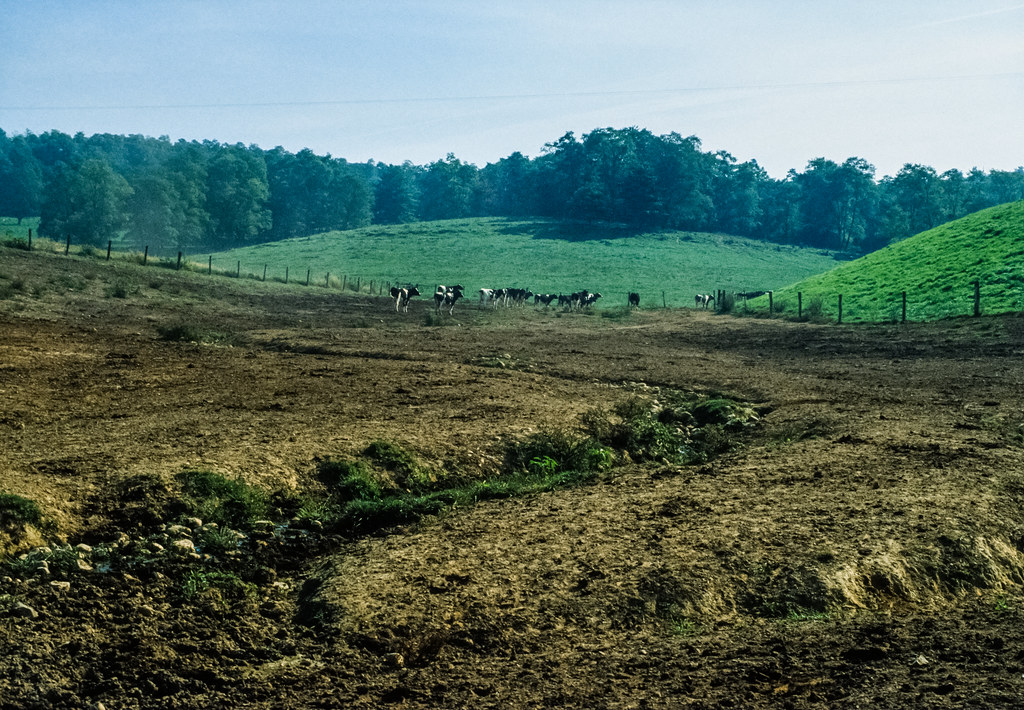
Land degradation

Exactly half of the world’s habitable land is now used for agriculture; 77% of that agricultural land is used for raising livestock,1 and 52% of that agricultural land is moderately or severely affected by land and soil degradation. 2
The main causes of land degradation are destruction of tropical forest canopy cover and biomass reduction,3 salinization, water and wind erosion, 4overgrazing and deterioration of soil quality.5
Salinization
A 2018 study showed that 20% of total cropland and 33% of irrigated agricultural land are salinized, partially due to salt-rich irrigation water. Another cause is drought, with agriculture consuming 70% of global fresh water use.6
Overgrazing
About 20% of the world’s pastures and rangelands, with 73% of rangelands in dry areas, have been degraded to some extent, mostly through overgrazing.7,8
Goats, sheep and cattle deposit manure, eat vegetation, harm trees and drink water. Overgrazing of grasslands, especially during drought, may lead to wind erosion and shrub invasion.
Soil erosion and degradation
Soil erosion from agricultural fields is estimated to be currently 10 to 20 times (no tillage) to more than 100 times (conventional tillage) higher than the soil formation rate.9
Soil quality is also degraded by overuse of fertilizers and pesticides. Chemical fertilizers, along with the use of heavy machinery and ploughing at the same depth10 (Mari) causes compaction of the soil, leaving less space between soil particles, reduced porosity and lower overall volume. The plant’s roots cannot penetrate the dense soil, reducing uptake of water and nutrients such as nitrogen, phosphorus and zinc,11 which can reduce crop yield more than 80%. Farmers then apply more chemical fertilizer to create a short-term fix, extending the vicious cycle. The long-term result is runoff, erosion and soil degradation.12

REFERENCES
- 1.Ritchie, H. & Roser, M . . Land Use. Oxford Martin School, University of Oxford; 2019:1. Accessed 2021. https://ourworldindata.org/land-use
- 2.ELD Initiative. The Value of Land: Prosperous Lands and Positive Rewards through Sustainable Land Management5. ELD Initiative; 2015:5. Accessed 2021. https://www.eld-initiative.org/fileadmin/pdf/ELD-main-report_en_10_web_72dpi.pdf
- 3.Miettinen J, Stibig H-J, Achard F. Remote sensing of forest degradation in Southeast Asia—Aiming for a regional view through 5–30 m satellite data. Global Ecology and Conservation. Published online December 2014:24-36. doi:10.1016/j.gecco.2014.07.007
- 4.Qadir M, Quillérou E, Nangia V, et al. Economics of salt-induced land degradation and restoration. Nat Resour Forum. Published online October 28, 2014:282-295. doi:10.1111/1477-8947.12054
- 5.Quinton JN, Govers G, Van Oost K, Bardgett RD. The impact of agricultural soil erosion on biogeochemical cycling. Nature Geosci. Published online April 18, 2010:311-314. doi:10.1038/ngeo838
- 6.Uri N. Cropland Soil Salinization and Associated Hydrology: Trends, Processes and Examples. Water. Published online August 3, 2018:1030. doi:10.3390/w10081030
- 7.Cheburkin A. Tactics in the teaching of the basic subjects of pediatrics in advanced training courses. Pediatriia. 1986;(2):56-58. https://www.ncbi.nlm.nih.gov/pubmed/3960647
- 8.Steinfield, H. et al. Livestock’s Long Shadow : Environmental Issues and Options. Rome: Food and Agriculture Organization of the United Nations; 2006. http://www.fao.org/3/a0701e/a0701e00.htmLivestock’s long shadow : environmental issues and options
- 9.Shukla, P. R. et al. Summary for Policymakers. In: Climate Change and Land: An IPCC Special Report on Climate Change, Desertification, Land Degradation, Sustainable Land Management, Food Security, and Greenhouse Gas Fluxes in Terrestrial Ecosystems. Intergovernmental Panel on Climate Change; 2009:12. https://www.ipcc.ch/srccl/chapter/summary-for-policymakers/
- 10.Mari GR. Effects of Soil Compaction on Soil Physical Properties and Nitrogen, Phosphorus, Potassium Uptake in Wheat Plants. Transactions of the CSAE,; 2008:74-79.
- 11.Barzegar AR, Nadian H, Heidari F, Herbert SJ, Hashemi AM. Interaction of soil compaction, phosphorus and zinc on clover growth and accumulation of phosphorus. Soil and Tillage Research. Published online June 2006:155-162. doi:10.1016/j.still.2005.03.004
- 12.Batey T. Soil compaction and soil management â a review. Soil Use and Management. Published online December 2009:335-345. doi:10.1111/j.1475-2743.2009.00236.x